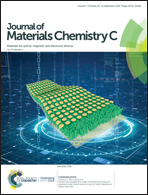Polydopamine/ZnO electron transport layers enhance charge extraction in inverted non-fullerene organic solar cells†
Abstract
The cathode interlayer plays a key role in the photovoltaic performance in organic solar cells. In this work, we demonstrate that polydopamine/ZnO can be used as efficient electron transport layers (ETL) in inverted non-fullerene organic solar cells. In comparison to the devices with the ZnO ETL, the power conversion efficiency of inverted PBDBT:ITIC solar cells with the PDA/ZnO ETL can be boosted from 10.15% to 11.14%, due to the simultaneously enhanced open-circuit voltage, short-circuit current and fill factor. The increased photovoltaic performance is mainly attributed to a faster charge extraction ability at the cathode interface and longer carrier lifetime, confirmed by transient optoelectrical analyses. Revealed by conductive-AFM and KPFM coupled with absorption spectroscopy, high optical transmittance and vertical electrical conductivity with a suitable low work function and a doping effect induced by PDA were observed in the PDA modified ZnO, which makes it a good ETL material for inverted solar cells and indicated universal applicability. This work provides a new approach to modify the cathode interfacial properties towards high efficiency organic solar cells with non-fullerene acceptors.



 Please wait while we load your content...
Please wait while we load your content...